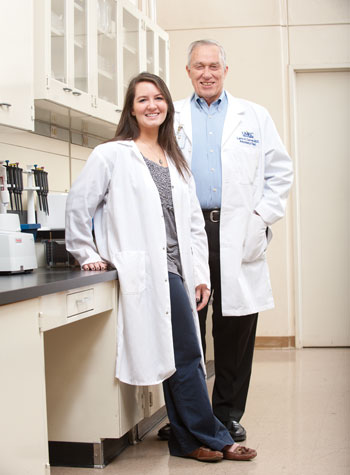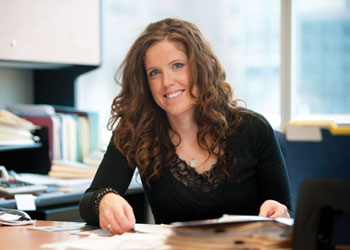by Portia Stewart // Spring 2012
Dear Mr. X,
I am writing to thank you for your considerate donation. It can be difficult to donate loved ones’ organs, especially the human brain. The brain is the home of our memories, our dreams and our hopes. The brain is the very essence of our being; therefore, we will treat it with the utmost respect. —Excerpt from UMKC Neuroscience Brain Tissue Bank donor letter
It’s about the size of a cantaloupe, weighing roughly 3 pounds, and it takes a lifetime to grow. Water, lipids, protein, carbohydrates, salt and soluble organic substances combine to create perhaps the most mysterious organ of the human body. Most of us are satisfied with ownership of one brain. But the researchers at the UMKC Neuroscience Brain Tissue Bank and Research Laboratory know they need more minds than the ones they were born with to solve the riddles of Alzheimer’s, Parkinson’s and Huntington’s disease, mental disorders, drug and alcohol addictions, stroke, cerebrovascular diseases and traumatic brain injuries.

A stone’s throw from Truman Medical Center at the UMKC School of Medicine is a nondescript lab with three freezers on loan from the University of Kansas. These are not your normal iceboxes. Two of them can reach temperatures of -80 degrees centigrade. Inside are the brains of nearly 150 donors who have given the gift of their organ, lent their minds, so to speak, to medical research. The third freezer, the “warmer” one, is set to -30 degrees centigrade. Brains are moved to this freezer when the researchers need to defrost them enough to take a sample. The temperature is key to preserving these valuable organs, because decay occurs rapidly once the body dies.
For a brain to find its way into this lab, a donor or family member must contact the brain tissue bank before the donor’s death. This is critical, because the lab can’t accept a donation without obtaining the donor’s medical records first. This information ensures the donor meets the criteria for donation.
Eligibility depends on several factors. First, the bank does not accept donations from people who died from highly contagious diseases, such as Creutzfeldt-Jakob disease, the human form of mad cow disease. Likewise, the lab can’t accept a brain donation if the person plans to make a whole body donation to a medical school. And finally, if the donor has been on a respirator a week or more, the brain can’t be accepted.
Many donations come from donors with age-related illnesses, such as Alzheimer’s. The bank also receives donations from members of the National Alliance on Mental Illness, who share a research interest in schizophrenia with Larry Carver, M.D., director of the UMKC Neuroscience Brain Tissue Bank and Research Laboratory. Oftentimes the families make the decision for donation in the hope that scientists will someday be able to use the brain tissue to further research that identifies the cause of brain diseases and leads to a cure.
Donation logistics

Jennifer Mitchell, the donor coordinator for the brain tissue bank and a UMKC master’s student in Social Work, says when families contact the lab in the case of a donor suffering from an age-related disease, it’s because the families want to give something back. “They’ve watched their family member deteriorate and they’ve already kind of suffered the loss of that family member years ago,” Mitchell says.
She works through the details of the donation with the family, planning the process for a donation that may not happen for years. But the details and timeline are critical once a donor passes. From the time the person dies to the time researchers freeze a brain is crucial. Ideally, the bank receives the brain within a couple of hours, but the bank sets the limit at 24 hours. Research shows that within the first two hours of death, the brain loses about 50 percent of its chemistry. After that, the decline is more gradual. But if researchers wait more than 24 hours to receive a donation, much of the information within it is lost.
If moving the brain from the donor to the lab is a race, it’s one that occurs on a carefully plotted course where the drivers and pit crews have prepared long before the start. And in the case of brain donation, no one is quite sure when the race will begin. So Mitchell gives family members her phone number with instructions to call soon after the donor’s death. Working with the funeral home, the body is transported to Truman Medical Center, where a pathologist removes the brain using incisions in the back of the head. This is important to many families who may still want the ability to have an open casket at the funeral.
What occurs next depends on the donor. If the person suffered from a neurological problem, one of the hemispheres is removed for a pathology report. The rest of the brain goes to the lab. There, the brain is cut into slices and frozen quickly using liquid nitrogen.
Then the brain moves into one of the -80 degree centigrade freezers, where it will stay until a researcher needs samples. When it’s time to remove a sample, the brain moves to the -30 degree centigrade freezer to thaw so it can be cut without cracking or crumbling. But researchers try to avoid thawing the samples too often, because oxygen will break down the sample, causing the loss of valuable information.
Illuminating the darkness
The voices in your head say others are trying to harm you or loved ones. You see things, but your friends and family insist they’re simply delusions. You know if you could just focus, you could explain what’s happening so someone else would understand. You are schizophrenic, and your illness most likely requires you to take antipsychotic medication for the rest of your life.
Carver’s dream is to unlock the key to schizophrenia, to understand how a schizophrenic’s brain is different than someone without the disease. What researchers have found so far is that schizophrenic patients have an overabundance of dopamine in the thalamus—about three times as much as the rest of us supposedly have. This leaves researchers with two big questions: How does the dopamine get there? And the question they say would cost a lot more money to solve—after it gets there, what does it do?
Carver launched a brain tissue bank in 1990 as a faculty member at Louisiana State University in New Orleans. His original goal was to gather enough tissue for his research about schizophrenia, but as word spread about his brain bank, requests for tissue began to roll in. The bank grew to meet the requests. In 2004, Carver returned to Kansas, which turned out to be a timely move, only a year before Hurricane Katrina hit New Orleans. Carver says it likely saved the brain bank from destruction. In 2007, the brain bank and lab found a home at UMKC. Today, the lab runs on a small staff, which mostly consists of volunteers. Researchers studying an array of health issues use the brain tissue the bank collects.
Typically, researchers who need samples of brain tissue will submit requests to the bank. While some researchers have come to the lab to collect the tissue, in many cases UMKC’s lab collects tissue from a diseased brain and a control brain. Then it’s marked and categorized for double-blind studies before it’s shipped to the researcher.
